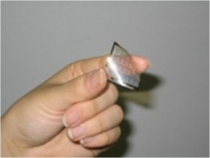Manufacture of flexible transistors using inkjet methods
2011-0909-02

- researcher's name
-
about researcher TAKENOBU, Taishi Guest Professor (retired)
- affiliation
-
Faculty of Science and Engineering School of Advanced Science and Engineering
- keyword
-
background
Sensors integrated into clothes and displays that can be rolled up and carried: in the near future, development of thin, flexible materials will be essential for creating such devices that are more closely incorporated into our daily lives.
The inkjet method, which uses inkjet printer technology to fabricate circuit boards (elements, wiring, etc.), is drawing attention as a means of resource- and energy-saving manufacturing. It is also a useful technology for realizing the goal of flexible electronics.
summary
It is possible to fabricate organic transistors onto plastic substrates by the inkjet method, by using a solution in which single walled carbon nano-tubes are dissolved in an organic solvent as the ink.
application/development
Expanding the range of application for the inkjet method allows the fabrication of an entire electronic circuit using the method.
Furthermore, by adjusting the solution concentration, it becomes possible to use it for the (almost) transparent wiring required for achieving transparent conductive film that does not use rare metals.
predominance
Carbon nano-tubes allow a larger current to flow than other organic materials. In 2007, the world’s highest level of performance was achieved with a transistor fabricated using the inkjet method. Moreover, due to the lack of need for heat treatment (annealing) during the manufacturing process, it is possible to fabricate at a lower temperature than normal (around 80ºC).
Today, the “Funding Program for Next Generation World-Leading Researchers: High-Performance Inkjet-Printed Electronics” is helping the advancement of research into applications.
purpose of providing seeds
Sponsord research, Collaboration research, Technical consultation
same researcher's seeds
-
 Organic light-emitting transistors
Organic light-emitting transistors -
 Light-emitting Electrochemical Cells(LEC)
Light-emitting Electrochemical Cells(LEC)
posted:
2014/05/21
